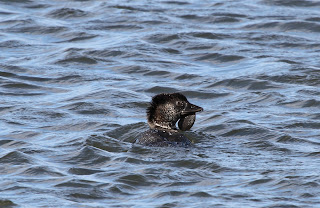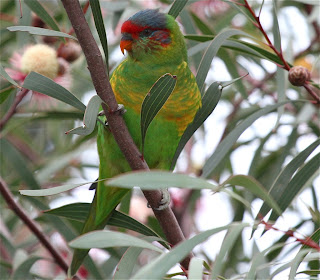A while back a friend said my camera was taking me away from
“birdwatching” and into “bird photography”. I disagreed on the grounds that the
camera was just an aid to the watching. With my eyes not showing me what her
younger, super-human vision shows her I replied: “I want to have a photo of
some of the birds I see. I want to learn more about the birds I see, not just
look at them. I want to use the photos to help me broaden my knowledge of birds
and maybe, just occasionally, find something that can be added to our overall
knowledge about birds. So, it is still the birdwatching that drives me, not the
photograph.”
Here is what I mean about seeing more when I birdwatch
with a camera:
1) Early on, with my first dslr camera, I was trying to get
a photo of an Eastern Whipbird. I sat hidden and waited for one to come to some
birdseed that had been set out. The bird finally appeared and started feeding.
As I watched and took photos I realised that the bird was only using its left
foot to hold the seeds, never its right foot. I searched through the birding
journals and found references to research on Eastern Whipbirds that
suggested the same thing, but there were no photos.
 |
| Eastern Whipbird holding seed in left foot |
2) Back in 2010 I saw a Satin Bowerbird that had moulted all
its head feathers. I thought this strange but then the next day, 200 kms away,
I found another one in the same condition. Now that was interesting. But then,
when we were on Norfolk Island this year, many of the European Blackbirds were
walking around with bare heads. Fascinating. I wonder if it is a normal moult
or do these birds have a dietary deficiency?
 |
| Bald Satin Bowerbird |
 |
| Bald Common Blackbird |
3) In the sporting world, baseball for example, players are
known to paint a black stripe on their cheekbone. It is meant to stop the glare
of the sun reflecting off the cheek and interrupting their view of the ball,
target, whatever. In birds though I am noticing a reverse strategy. Lots of
bird species have either a row of white dots or a white line on or near the
bottom eyelid. Now what on earth could be the reason for that?
 |
| Reed Warbler |
 |
| Shy Heathwren |
 |
| White-browed Scrubwren |
 |
| Black Noddy |
 |
| Brown Noddy |
 |
| Australian Spotted Crake |
4) Down in a wonderful coastal park in Victoria called
Croajingolong there is a slope of heath-land overlooking Bass Strait where I
know I can find Southern Emu-wrens. With the aid of my camera and some patience
I now know that Southern Emu-wrens have whiskers like a cat, white dots below
the eyes and yellow pads on the bottom of their feet. Now isn’t that
fascinating!
 |
| Southern Emu-wren, female |
5) At Werribee on the 29th April we found a lone
Curlew Sandpiper. This is very late in the year for a Curlew Sandpiper to be
around the Melbourne area and as the bird did not flush as we drove up to it
and stopped I got a series of images over 4 minutes. We then drove quietly away
and left the bird standing beside the track. When I put the pictures on the
computer I could see that in every photo the bird’s eyes were clouded over, as
if the nictitating membrane was stuck over them, or the bird was unwell. Could
partial blindness be the reason the bird did not migrate with its fellows?
 |
| Curlew Sandpiper |
And as I was in the process of writing these thoughts, I
came across an item from the ABA blog in America. The author’s motivation is
different from mine but his comments relate directly to what I am trying to say
– there is more to birdwatching than just looking at birds. If you are
interested, have a look at
http://blog.aba.org/2012/04/open-mic-resources-for-a-displaced-birder.html
Oh, and by the way, not that I would admit it to my friend, it is rather fun taking pictures of birds and taking the pictures has changed my birding trips, just a bit (smile).
All images © Jenny Spry not to be used without written permission












































